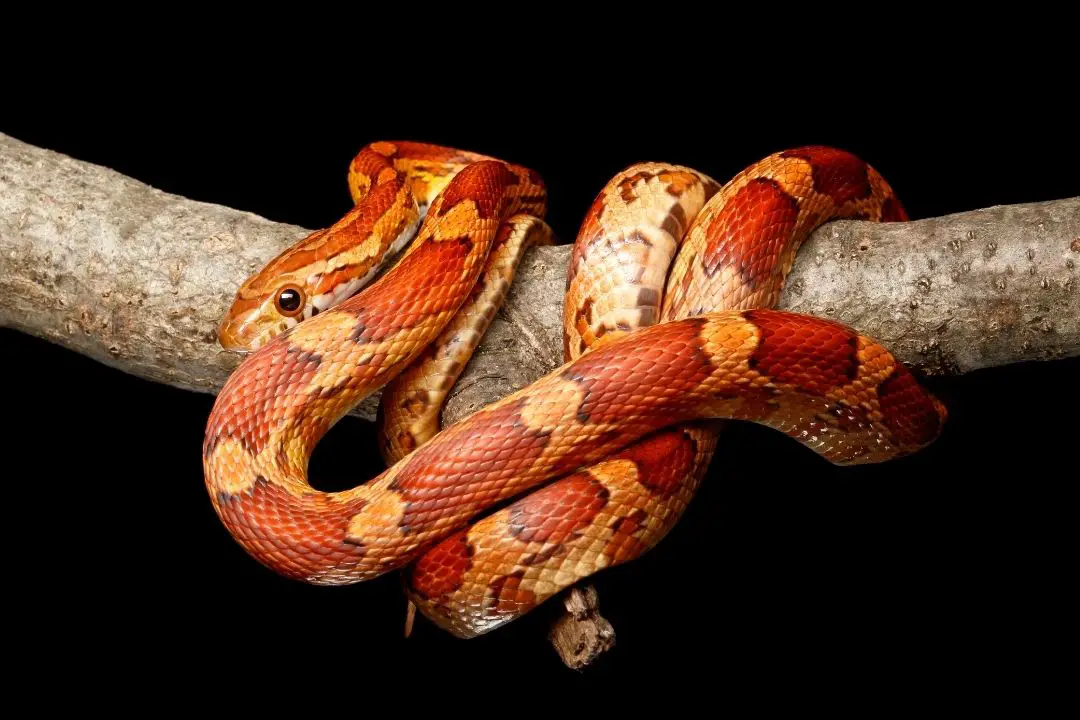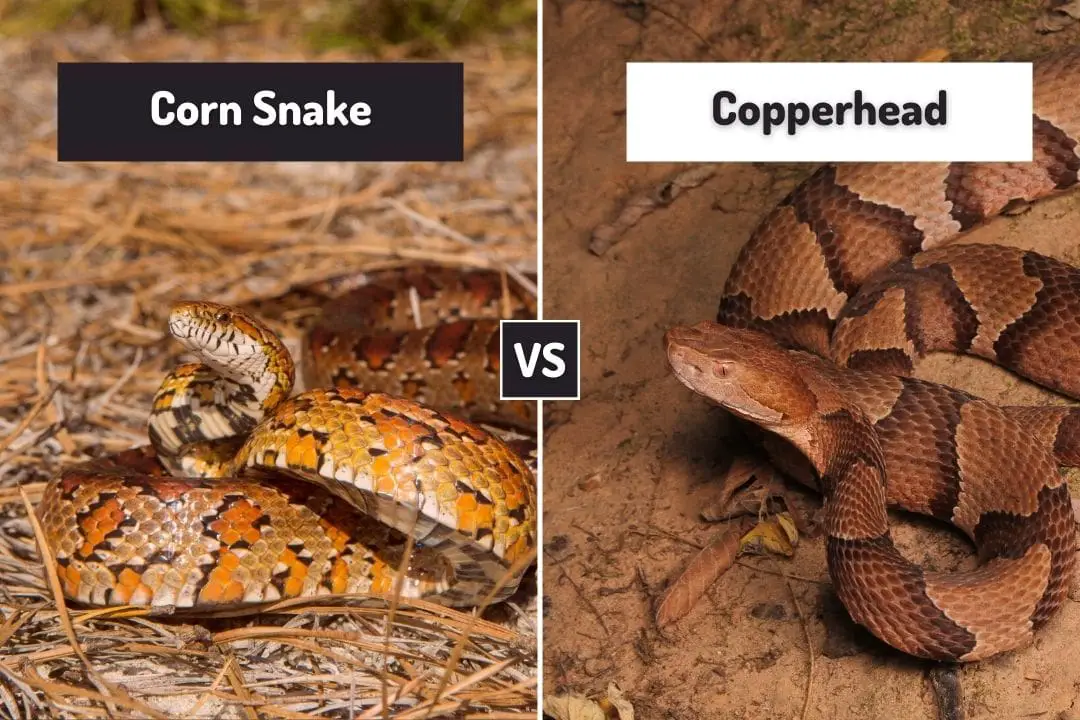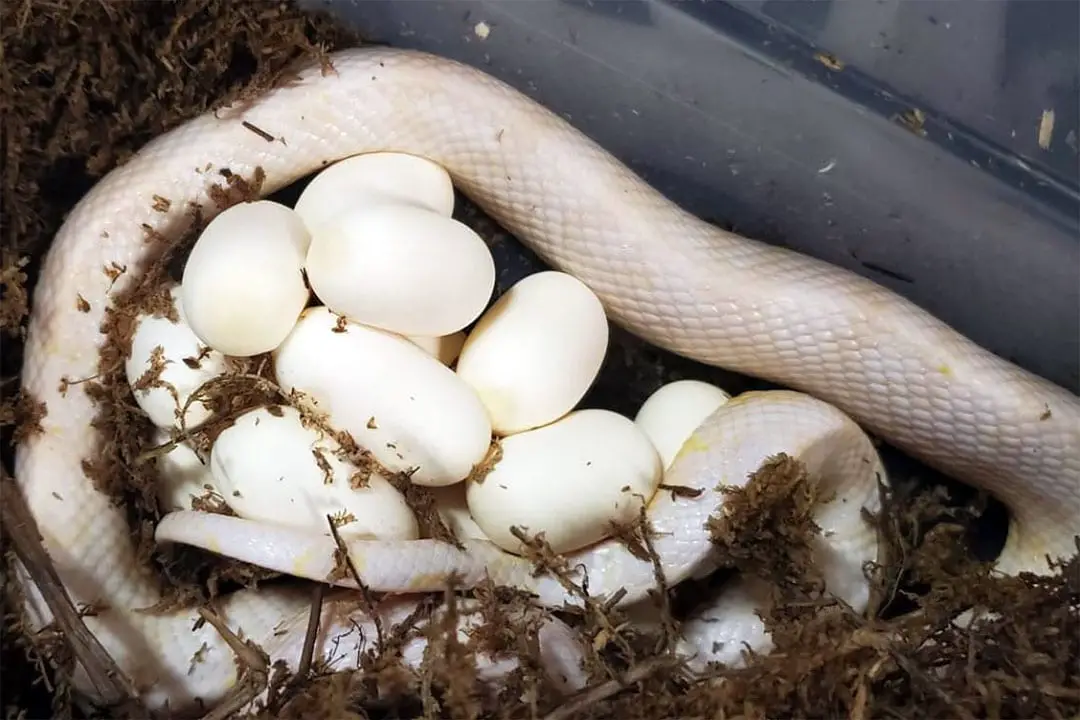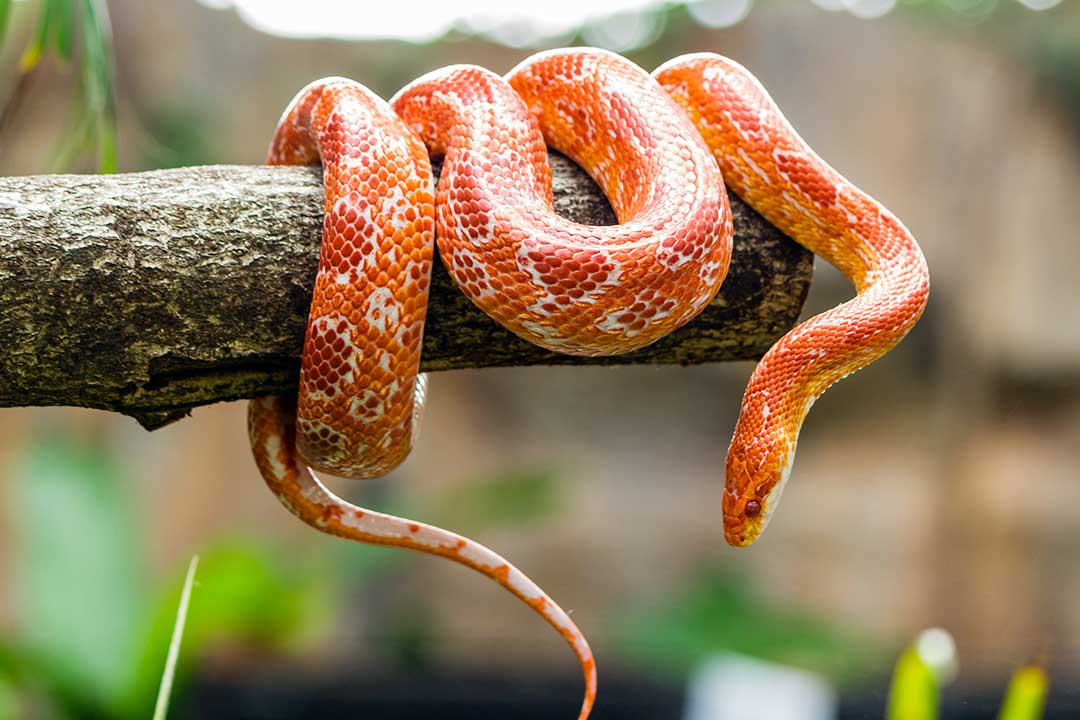Corn snakes (Pantherophis guttatus) are wonderful animals and make great pets. If you are interested in owning a corn snake, this care sheet will help you learn everything you need to get you and your new pet off to a great start.
Corn Snake Enclosure
The first thing you need for your corn snake is a secure enclosure.
You want it to be large enough for the snake to stretch out fully and have plenty of room for essential items like hides and the water dish. For an adult snake, you want it to be the length of your snake along the longest dimension of the enclosure at a minimum.
The width and height should both be about half the snake’s body length. This makes sure your snake has enough room to stretch out and plenty of space to explore and get exercise.
You need to make sure the enclosure is escape-proof. This means a secure lid or front access doors that your snake can’t get open.
As for materials, plastic, wood, and glass can all work. Glass aquariums are common, but don’t hold heat well, and access from the top is far from ideal. Wood retains heat better but can have issues with cleanliness.
Plastic wears down and may need to be replaced more often. You also need to watch any heating elements since they can melt the cage.
Enclosure For Baby and Juvenile Corn Snakes
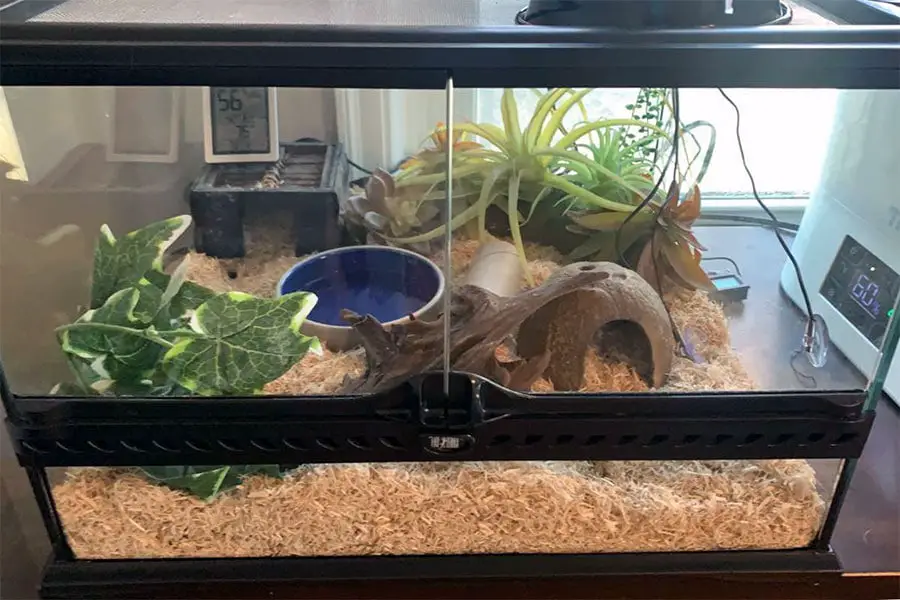
An enclosure for hatchlings and juvenile corn snakes needs to be extra secure and well-sized to handle the snake as it grows.
A corn snake will double in length and weight easily during its first year and will reach adult size by the time it reaches two years of age.
You should get a terrarium that will be large enough for at least a year and fill it with plenty of hides and decor so your snake doesn’t feel exposed.
Feeling exposed makes hatchlings and juveniles stressed out and more likely to bite you.
Once your snake reaches twice the length of its enclosure, you should replace it with a larger one.
An enclosure that opens from the front rather than the top will make it easier to feed and handle young snakes. They typically dislike anything coming from above since that is how a predator would attack them.
This terrarium from Exo-Terra is a good example of a secure enclosure for a hatchling. It has front-access doors, a secure lock, good ventilation, and it is raised for placing under-tank heaters.
There is also cable management. Corn snakes are typically 8-12 inches when they hatch, so this would work for some time before your snake will need a larger tank.
Enclosure for adult corn snakes
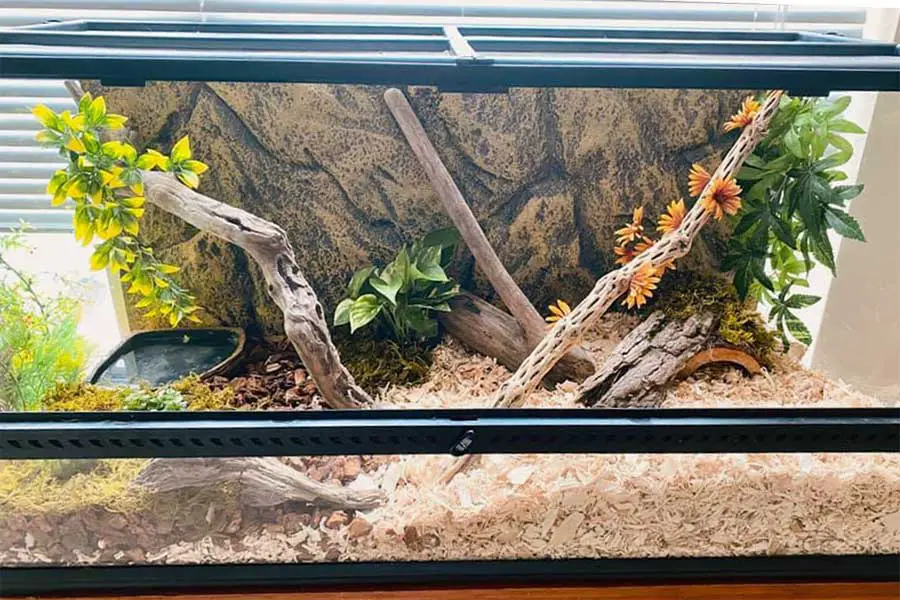
For adults, you want a tank that is at least 20 gallons in size.
An adult corn snake will be between 3 and 5 feet, though some grow to 6 feet in length.
Your snake should be able to fully stretch out on the diagonal. You should get a larger enclosure if you can fit it, and make sure to fill the space. With any reptile, you need to avoid open space so your snake feels secure.
The more room your snake has, the more it will explore and get the exercise it needs to stay healthy. If you can fit it, get an enclosure that is at least the length of your snake long.
There needs to be good ventilation and it needs to be escape-proof. An adult corn snake is much stronger than you would think. Front doors give you better access to your snake from the side, where it is less likely to view you as a predator.
This enclosure from REPTIZOO is a good example of a cage. It has good ventilation, a secure lock, and front access doors.
You can also place the under-tank heaters easily, and you can stack these enclosures if you get more snakes in the future. This would fit a smaller corn snake well, but you should pick a longer tank if you end up with a long snake.
Substrate
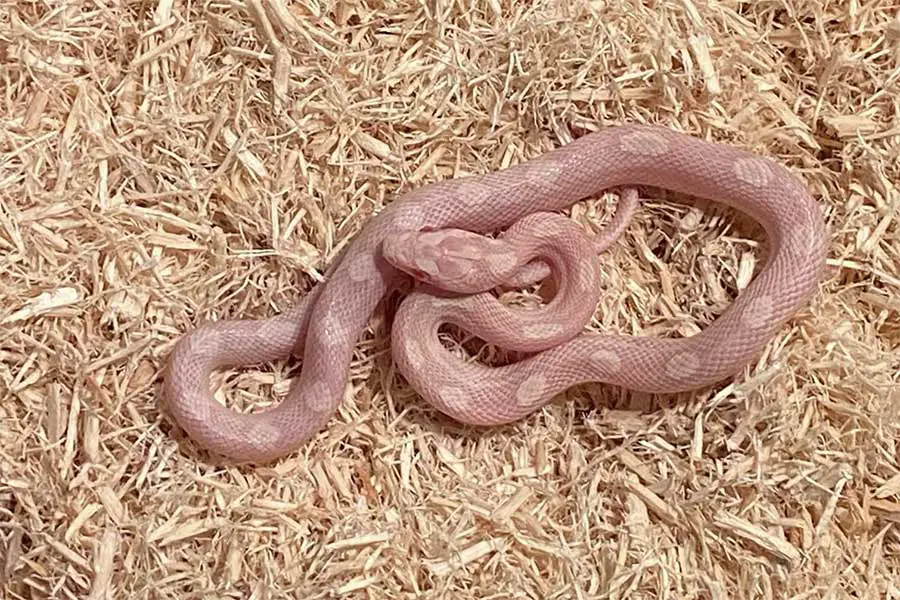
Once you have your enclosure, you need a substrate. A substrate is important to keep the enclosure comfortable for your snake and help maintain proper humidity. It also helps keep your snake’s home hygienic with proper maintenance.
One of the best substrate options is aspen bedding. It contains no toxic oils like pine and allows snakes to create burrows and dig like they do in the wild. Pile it up 3 inches deep and your snake will have plenty of room to burrow.
It is also easy to clean. You do need to feed in a separate container to reduce the risk of your snake eating the bedding and getting an impaction. There are a few types of wood beddings that are safe, but you should never use anything that isn’t meant for reptiles or made of pine and other aromatic woods.
The aromatic oils can cause respiratory distress in snakes, and other contaminants can make your snake ill if it isn’t meant for snakes.
If you would like other options, reptile carpet is popular. This is typically an indoor/outdoor carpet that is soft enough to be comfortable for your snake. If you have two pieces, you can easily pull out the dirty one and replace it with the clean one instantly.
The biggest problem is the look and that it doesn’t really allow burrowing behaviors.
Paper is another option, either shredded or solid. Shredded paper allows burrowing, but it can be ingested. Solid paper sheets are easy to clean since you just remove the soiled sheet and replace it.
However, they don’t allow burrowing and aren’t very attractive. If you choose paper bedding, get paper that is meant for reptiles. You may have heard you can use newspaper, but the ink in newspaper can harm your snake.
Coconut fiber and soil sold for reptile cages are great if you want a more natural-looking setup. Just be careful since they can cause higher humidity levels.
Heating
Heating is essential for a corn snake. They need a gradient of temperature in the enclosure so the snake can thermoregulate easily. You want about 75 on the cool side and 80-85 on the warm side. Get an infrared thermometer to make sure the temperature is right.
You should also have a thermometer in the enclosure at all times, though you should confirm they are accurate regularly. One at each end is best. A heat mat and thermostat to control it is the best solution for heating.
Ceramic bulbs are a common choice for reptile heating, but they can dry out the enclosure and cause shedding problems. If you live in a cold climate, you can add a ceramic heating bulb to your setup.
Just make sure you keep your humidity between 40-50%. You may need to mist the enclosure to get it up to the right level and refill the water more often.
Light
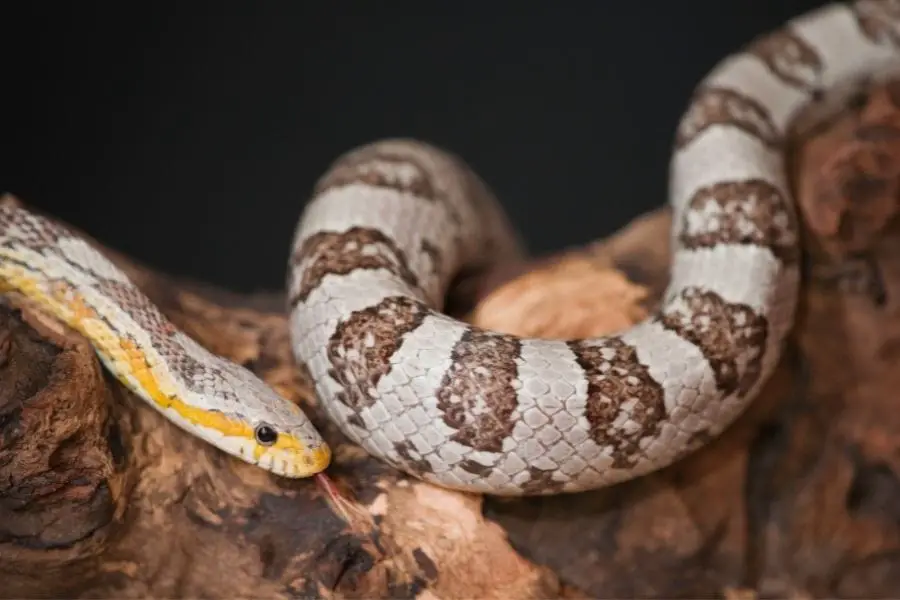
Snakes don’t need special UV bulbs to stay healthy.
You can use lights for aesthetic reasons, but be sure you watch that the enclosure doesn’t get too hot. If your enclosure is near a window, you also need to watch the temperature.
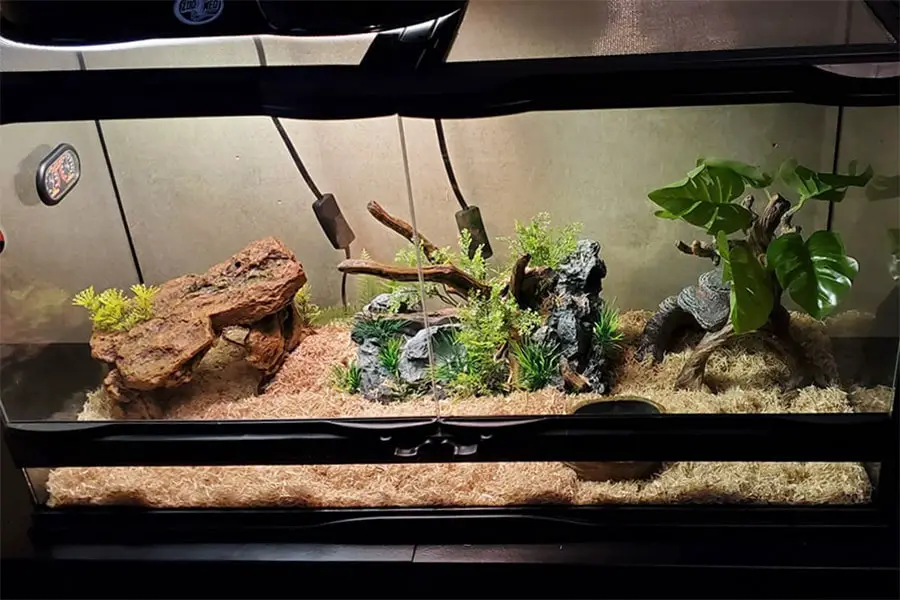
Some owners do take their snake outside for half an hour when it is warm to give them some sun. This shouldn’t hurt your snake, just make sure your snake doesn’t escape.
Shelter
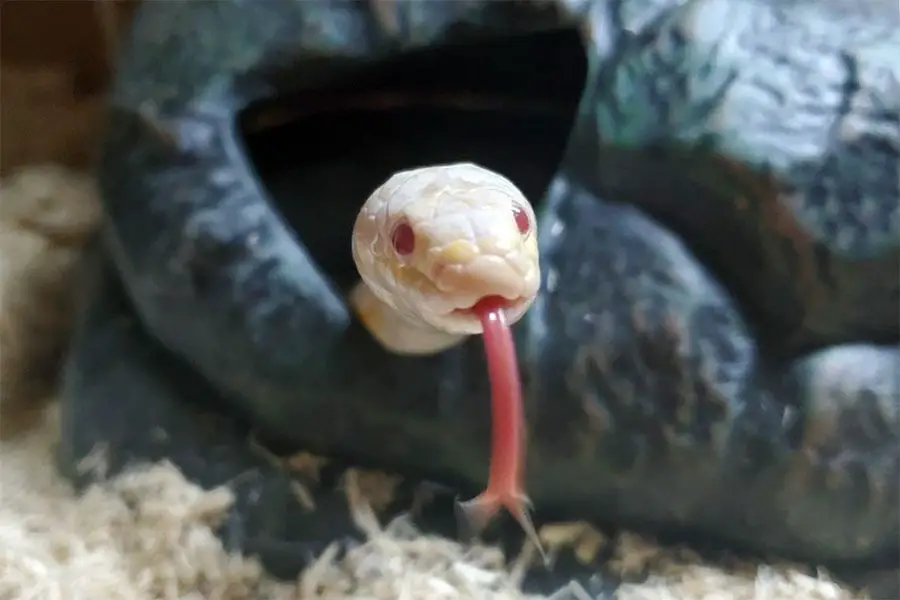
Corn snakes in the wild spend much of their time burrowing underground or in hides. This helps both with keeping humidity at a safe level for shedding and safety from predators.
All corn snakes will do their best to stay out of exposed areas to reduce the risk of being eaten by predators. Your corn snake needs you to provide shelter for them.
Get or make hides that are large enough for the whole snake to fit inside, while not leaving so much room that the snake feels exposed.
You need at least 2, positioned at the warm and cool sides of the enclosure. If you are using a substrate that allows burrowing, placing a piece of bark on the substrate can function as a bonus hide.
Make sure the hides you use are easy to clean and sanitize. Remember to keep your hides the right size for your snake, and make sure that they can be fully enclosed in them. Fill up any empty space with fake greens and branches to let the snake climb.
Water
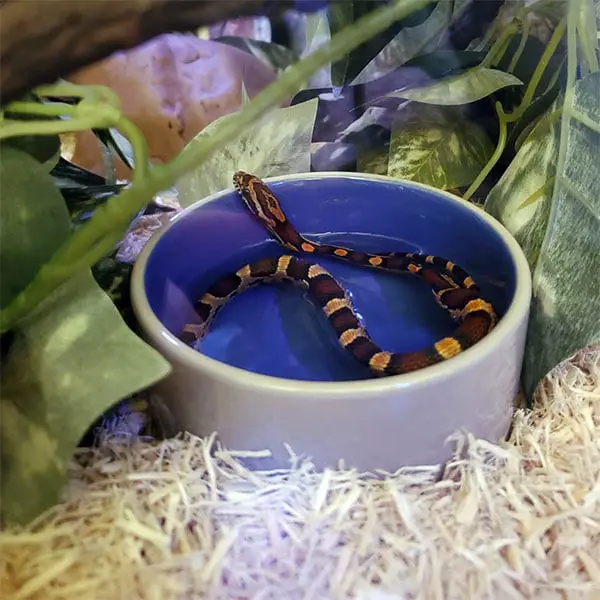
All snakes require access to fresh drinking water that you replace at least every 2 days. You should provide it in a container that can’t be tipped over and allow the snake to soak its whole body easily.
This is a good example for snakes, but large adults may need a larger bowl. Remember that it should be nonporous and easy to clean with a reptile-safe sanitizer to keep your snake healthy.
Make sure to dechlorinate the water for your snake’s health if you use tap water. Chlorine levels in water are tuned for humans, not snakes.
Humidity
Corn snakes need proper humidity so they can shed easily. A stuck shed can harm your snake. You should keep the humidity at 40-50% and monitor it with a reliable hygrometer.
If you are using a heating bulb, misting is essential to keep up humidity levels. Misting a few times a day can help if your humidity is too low generally.
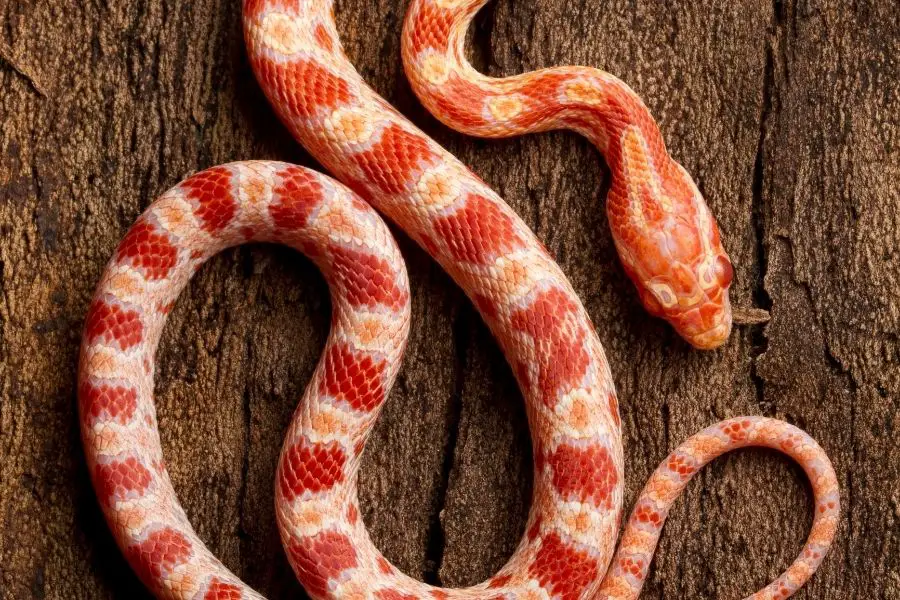
When your snake is getting ready to shed, add sphagnum moss to a hide on the warm side can help make sure your snake sheds well. Just make sure the moss you use is meant for reptiles.
This moss can also help if you are in a dry climate. Just make sure it is damp, not wet. Too much standing water can give your snake an infection.
Enclosure Maintenance
Keeping your snake’s enclosure clean is important for your snake’s health. Snakes only eliminate once or twice a week, so they are easy to keep clean. Here is a list of tasks broken down by how often you should do them.
Daily Tasks
- Spot cleaning any waste
- Replacing the water
- Checking temperature and humidity levels
Weekly
- Clean water dish with a reptile-safe cleaner
Once a month you should do a full cleaning of the cage. You will need a disinfectant that is reptile safe, paper towels, new bedding, and a trash bag at a minimum.
Put your snake in a temporary cage like a plastic storage tub with air holes drilled into it. Then unplug everything and remove all the hides and decorations to be cleaned into a sink or tub.
Then, remove all the bedding and start scrubbing the tank to remove any feces or dust. Make sure you don’t spray the hot glass with anything cold or it might crack!
Next, use a reptile-safe sanitizer or a 5% bleach solution to clean the whole tank and rinse it away thoroughly. Leave the enclosure open so it can dry while you clean up the water dishes and hides.
Be gentle to make sure you don’t scratch them, but clean them thoroughly along with any decorations. Once they are clean and everything is completely dry, you can add 3 inches of fresh bedding and replace all the hides.
Make sure you fill-up the water dish. Then you can put your snake back and plug everything back in. Don’t forget to make sure all latches and locks are secure.
Feeding your Corn Snake
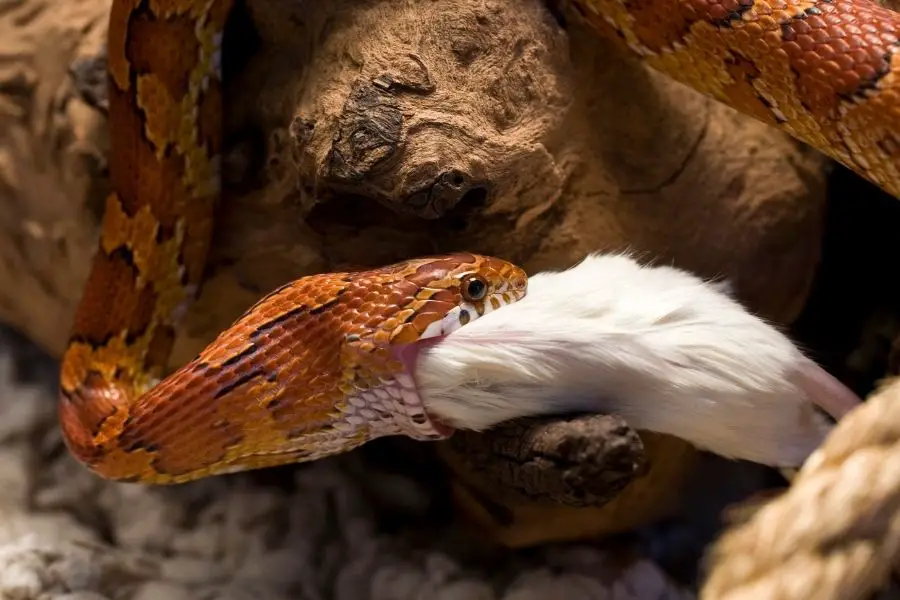
Corn snakes in the wild eat rodents, small lizards, amphibians, and even birds and their eggs. In captivity, corn snakes eat mice or rats.
The size of the prey item should be no more than 1.5x the width of the snake. Your snake should have a small visible lump after feeding. If you don’t see this, it may be time to size up the prey or offer two mice in one feeding.
If you want a more reliable option for figuring prey size, go with weight. Weigh your snake in grams, and feed it something that is 10-15% of its weight.
For hatchlings, one pinky mouse is enough. An adult will eat an adult mouse or equivalent rat.
Picky adult corn snakes may prefer a younger rat over an adult mouse or prefer only certain colors of the mouse. Rats can be fed to older snakes, just feed less often since they are more nutritious and may make your snake fat.
Frozen Vs Live Prey

This is a major debate among snake owners. Let’s go over the pros and cons of each to help you decide.
Live-feeding Pros:
- Creates natural behaviors
- May be the only way to get a snake to eat
- More nutrients for the snake, but only barely
Live-feeding Cons:
- Prey may have parasites that can make your snake sick
- Cornered prey can fight back and injure or kill your snake
- Cruel to the mouse
- Harder to keep a stock of food
- More expensive
Frozen Pros:
- No worries about your snake being harmed
- Kinder to both animals
- Easy to keep a stock of food on hand
- Cheaper to buy in bulk
Frozen Cons:
- Takes time to properly thaw the food
- Some snakes won’t take it easily
- Slightly less nutrients for the snake, but this is very small
For frozen, you can have them delivered to your door.
Local reptile and pet shops will also likely carry frozen mice in a variety of sizes. If you want to be sure you get the right size, check out Rodent Pro, Big Cheese Rodents, Perfect Prey and Layne Labs.
Live mice cannot be shipped through the mail. If you want to feed live prey, the best sources are a local breeder or reptile keepers. Some reptile breeders also breed their prey items and may have extra.
Check local boards on Facebook or craigslist to find live prey in your area. Reptile shows also have them, and you can call local pet shops and reptile shops to find if they have prey that is the right size for your snake.
How Often to Feed Your Corn Snake
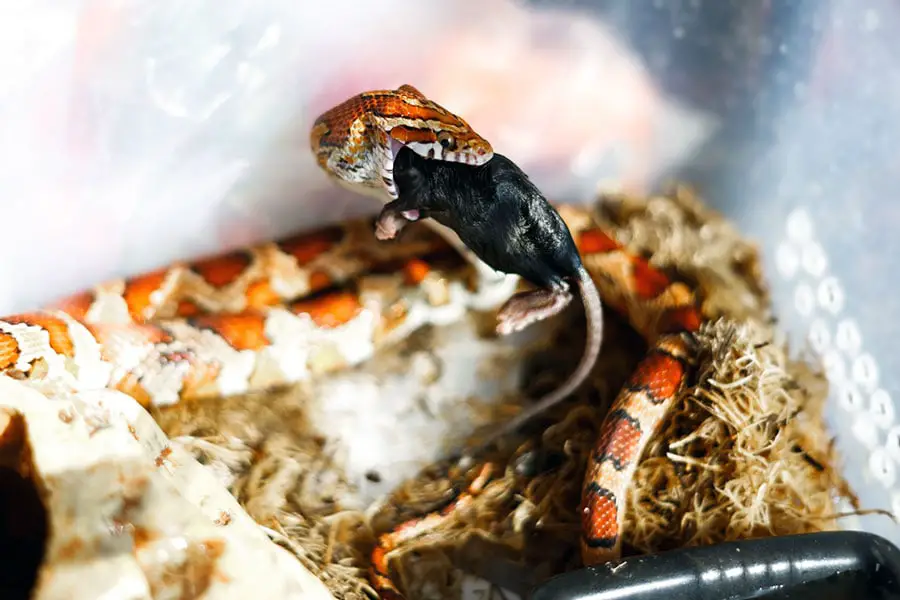
- Hatchling corn snakes need to eat every 5-7 days.
- Juvenile corn snakes eat every 7 to 10 days
- Adult corn snakes are typically every 10-14 days. If you feed rats to an adult snake, feed every 2-3 weeks.
Use a kitchen scale to weigh your snake regularly. You can track growth in young snakes and make sure adult snakes are maintaining a healthy weight.
Remember, you shouldn’t see any exposed skin between scales on a snake if it hasn’t fed recently, and you shouldn’t see bones easily.
Shedding
Shedding is how snakes make room to grow. When it is time to shed, a thin layer of fluid builds up between the old skin and the new one.
This allows the snake to slip out of the old skin easily. When your snake is ready to shed you will see its colors dull and eyes go cloudy. It will also become more timid or irritable and likely won’t eat.
The cloudy eyes will clear up after a few days, and then it will shed after a few more days.
You will notice your snake rubbing on decorations or the side of the enclosure to try to get the old skin off. Hatchlings will shed every 4-6 weeks on average, with the rate of shedding decreasing as the snake ages.
Adult corn snakes will only shed every three months or so.
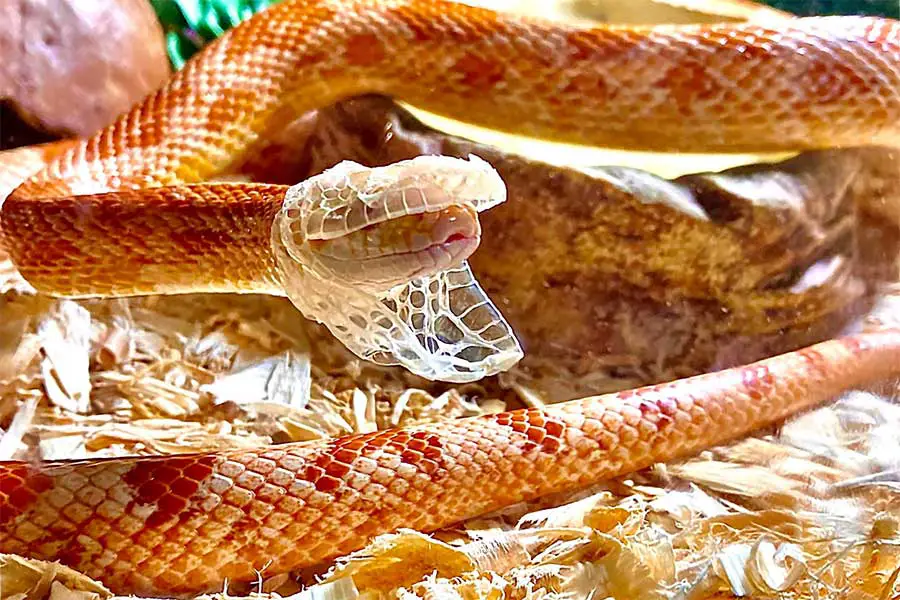
When your corn snake starts to dull in color, you need to offer a hide on the warm side filled with damp moss. This will help make sure your snake gets the whole skin off in one go.
If it doesn’t, any stuck pieces of skin will harden and cause injury. The most likely areas to stick are the tail tip and the area around the eye. If the tail tip sticks, it can constrict blood flow to the tail and lead to your snake losing it. Stuck shed around the eyes can lead to infections.
Make sure to check the old skin to make sure it came off in one piece.
If you notice pieces missing, such as the caps over the eyes, you should either offer a damp hide or soak the snake in warm water for half an hour.
Then you can use tweezers to carefully try to remove the stuck shed. If it won’t come off, soak the snake again.
Hibernation
Snakes go into brumation, which is similar to hibernation in mammals. During cold months, snakes in the wild will become less active.
They won’t eat and will only wake up to drink before going back to sleep. There is no need to induce brumation in your snake. It is only needed to trigger breeding. However, you may notice that the change in light levels may make your snake eat less often.
This is normal, just offer food when the snake shows signs of hunger like searching the enclosure for prey.
Handling
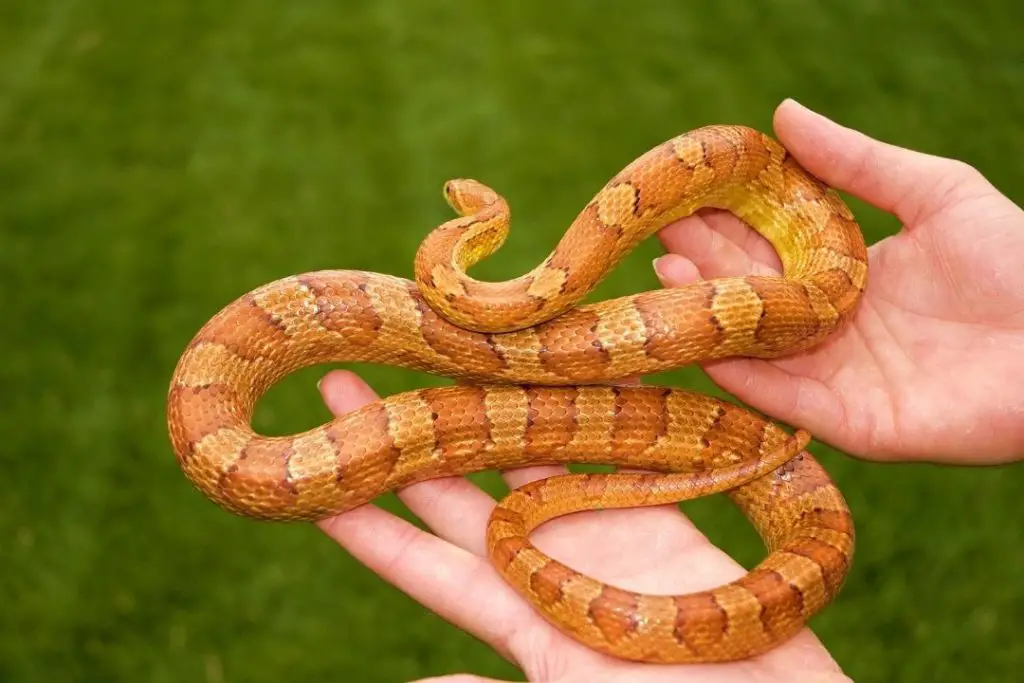
Corn snakes typically take well to handling so long as you keep a few facts in mind.
First, make sure your hands are clean and don’t smell like a food item or other snakes. Snakes have an amazing sense of smell and may mistake you for prey and bite you.
Second, never approach your corn snake from above. This mimics a predator and will frighten them. Make sure your snake sees you approach.
If your snake was sleeping, you could startle it and get bitten. Pick up the snake by sliding under its body from the side and lift them up while supporting as much of the body as you can.
Handle your snake for no more than 5 minutes to start, and return the snake to the enclosure once they are relaxed and ready to explore. This helps teach them that handling isn’t a bad thing.
You can extend handling sessions as your snake gets used to them, but keep under half an hour even for adults since they can get too cold outside their enclosure.
Common Issues
My Corn Snake Isn’t Eating
Corn snakes may refuse food for a number of reasons. Snakes that are about to shed will refuse food, they will also refuse to eat if they aren’t hungry. Snakes in poor conditions such as an enclosure that is too cold will also refuse to eat.
Check all the conditions to make sure they are right and fix any issues.
Some snakes are picky about food. They might refuse a light-colored mouse if they are used to dark mice or the opposite may occur. Some hatchlings show a heavy preference for lizards or frogs.
Snakes can also refuse to eat during winter. Thankfully, snakes can go about 2 months without food before it starts to be a problem. Give your snake some time in their enclosure with proper temperature and humidity and try feeding them a few days later with a fresh mouse.
If they start looking sickly or are losing a lot of weight, take them to a reptile vet. Illness is another big reason for refusing food. Any signs of infection should be treated as soon as you notice them by a qualified reptile vet.
Regurgitated Food
Regurgitating food is very bad for snakes. It is typically caused by stress or the prey being too big. Some parasites in the snake or prey also cause regurgitation.
Make sure you don’t handle your snake for a few days after feeding and get to a vet if your snake keeps regurgitating. Watch out for a bulge in the stomach if your corn snake hasn’t eaten. This is a sign of a parasite that thickens the stomach lining. It is very likely to transfer to other snakes, so be careful and keep up on good hygiene.
Respiratory Infections
Repiratory infections in a corn snake appears as a wheezing or rattling noise while breathing or excess mucus. Snakes may become lethargic and refuse to eat.
It can be caused by bacteria from poor hygiene or the wrong humidity and temperature. Make sure the enclosure is clean and at the right conditions and take your snake to the vet.
Sources
- Cabi.org – Pantherophis Guttatus
- AnimalDiversity – Red Corn Snake Info sheet
- Virginia Herpetological Society – Red Corn Snake
Final Words
Hopefully this gives you a good idea about how to care for a corn snake. If you have any comments or questions, please leave a comment below.
